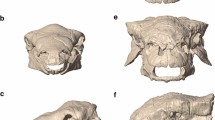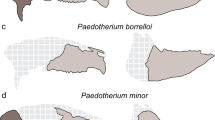Abstract
The form and function of the masticatory apparatus of the fossil genera Vassallia and Holmesina are analyzed so that the possible dietary behaviors of these pampathere xenarthrans might be inferred. Analysis is based on comparisons of dental morphology and skeletal features (through RFTRA) associated with the masticatory musculature among the pampatheres, the extant dasypodids Euphractus and Dasypus, and the glyptodont Propalaeohoplophorus. A method is proposed for generating a moment arm of the massetericus independently of the muscle's line of action, which allows direct comparison among extant and fossil mammals. The masticatory apparatus of the pampatheres strongly resembles that of Euphractus among extant forms, but the development of muscular attachment sites indicates a more powerful musculature, particularly the massetericus; the taxa differ most markedly in dental morphology. Long moment arms about the jaw joint and large ratios of muscle to bite moments indicate forceful rather than quick movements. The various skeletal and dental features analyzed suggest that the masticatory apparatus of the pampatheres was more powerful and efficient in transverse chewing than in dasypodids and that they were primarily grazers consuming mainly coarse vegetation. These features, some shared with herbivorous ungulates, include wide, relatively flat mandibular condyles; condyles well dorsal to muscular insertion sites; expanded angular processes; unfused symphysis; a posteriorly extended tooth row; open-rooted teeth; mesial teeth that bear mainly transverse striations; distal teeth that are mesiodistally elongated, bear basined occlusal surfaces, and in Vassallia possess a central island of resistant dentine that acted as a functional analogue of an ectoloph; and teeth with a stepwise arrangement. The results of this study indicate that detailed analysis and comparison of morphology lead to useful predictions of behavior.
Similar content being viewed by others
LITERATURE CITED
Benson, R. H., Chapman, R. E., and Siegel, A. F. (1982). On the measurement of morphology and its change. Paleobiology 8(4): 328–339.
Carlini, A. A., and Scillato-Yané, G. J. (1993). Origin and evolution of “glyptodontoids.” J. Vert. Paleont. 13(3) (Suppl.): 28A.
Cartelle, C., and Bohorquez, G. A. (1985). Pampatherium paulacoutoi, uma nova espécie de tatu gigante da Bahia, Brasil (Edentata, Dasypodidae). Rev. Bras. Zool. 2(4): 229–254.
Castellanos, A. (1927). Breves notas sobre los clamidoterios. Publ. Cent. Est. Ing. Rosario 1–8, Argentina.
Chapman, R. E. (1990a). Conventional Procrustes approaches. In: Proceedings of the Michigan Morphometrics Workshop, F. J. Rohlf and F. L. Bookstein, eds., pp. 251–267, Special Publication No. 2, University of Michigan, Ann Arbor.
Chapman, R. E. (1990b). Shape analysis in the study of dinosaurs morphology. In: Dinosaurs Systematics: Perspectives and Approaches, K. Carpenter and P. J. Currie, eds., pp. 21–42, Cambridge University Press, London.
Chapman, R. E., and Brett-Surman, M. K. (1990). Morphometric observations of hadrosaurids ornithopods. In: Dinosaur Systematics: Perspectives and Approaches, K. Carpenter and P. J. Currie, eds., pp. 163–176, Cambridge University Press, London.
De Iuliis, G. (1988). A reconstruction of the jaw adductor musculature in Hyaenodon crucians, H. horridus, Proviverra grangeri and Patriofelis ulta (Creodonta, Mammalia) and a reassessment of the classification of the mammalian masticatory apparatus. Unpublished M.Sc. thesis, University of Toronto, Toronto, pp. 1–308.
De Iuliis, G., and Edmund, G. Description of Vassallia maxima Castellanos, 1946 from Puerta del Corral Quemado, Catamarca Province, Argentina. Smithson. Contrib. Paleobiol. (in press).
Downing, K. F., and White, R. S. (1995). The cingulates (Xenarthra) of the Leisey Shell Pit local fauna (Irvingtonian), Hillsborough County, Florida. Bull. Fla. Mus. Nat. Hist. 37: 375–396.
Edmund, G. (1985). The fossil giant armadillos of North America (Pampatheriinae, Xenarthra = Edentata). In: The Evolution and Ecology of Armadillos, Sloths and Vermilinguas, G. G. Montgomery, ed., pp. 83–93, Smithsonian Institution Press, Washington, DC.
Edmund, G. (1987). Evolution of the genus Holmesina (Pampatheriidae, Mammalia) in Florida, with remarks on taxonomy and distribution. Pearce-Sellards Ser. Tex. Mem. Mus. 45: 1–20.
Engelmann, G. F. (1985). The phylogeny of the Xenarthra. In: The Evolution and Ecology of Armadillos, Sloths and Vermilinguas, G. G. Montgomery, ed., pp. 51–64, Smithsonian Institution Press, Washington, DC.
Fariña, R. A. (1993). Análisis filogenético de Glyptodontia. Ameghiniana 30(3): 329–330.
Fariña, R. A. (1995). Paleobiología de los grandes mamíferos lujanenses, Unpublished Doctoral Thesis, Universidad de la República, Montevideo, Uruguay.
Finch, A. E. (1982). The discovery and interpretation of Thylacoleo carnifex (Thylacoleonidae, Marsupialia). In: Carnivorous Marsupials, M. Archer, ed., pp. 537–551, Royal Zoological Society of New South Wales, Sydney.
Flynn, J. J., and Swisher, C. C. (1995). Cenozoic South American Land Mammal Ages: correlation to global geochronologies. SEPM Spec. Publ. No. 54: 317–333.
Gambaryan, P. P., and Kielan-Jaworowska, Z. (1995). Masticatory musculature of Asian taeniolabidoid multituberculate mammals. Acta Palaeont. Polonica 40(1): 45–108.
Gaudin, T. J. (1995). The ear region of edentates and the phylogeny of the Tardigrada (Mammalia, Xenarthra). J. Vert. Paleont. 15(3): 672–705.
Greaves, W. S. (1973). The inference of jaw motion from tooth wear facets. J. Vert. Paleont. 47(5): 1000–1001.
Greaves, W. S. (1978). The jaw lever system in ungulates: A new model. J. Zool. London 184: 271–285.
Hoffstetter, R. (1958). Xenarthra. In: Traité de Paléontologie, J. Piveteau, ed., Vol. 6(2), pp. 535–636, Masson et Cie, Paris.
Hulbert, R. C., and Morgan, G. S. (1993). Quantitative and qualitative evolution in the giant armadillo Holmesina (Edentata: Pampatheriidae) in Florida. In: Morphological Change in Quaternary Mammals of North America, R. A. Martin and A. D. Barnosky, eds., pp. 134–177, Cambridge University Press, London.
Jarman, P. J. (1974). The social organisation of antelope in relation to their ecology. Behaviour 48: 215–267.
Lydekker, R. (1894). Contributions to a knowledge of the fossil vertebrates of Argentina, Part II: The extinct edentates of Argentina. An. Museo de La Plata Pal. Arg. 3: 1–118.
Macalister, A. (1869). On the myology of Bradypus tridactylus; With remarks on the general anatomy of the Edentata. Ann. Mag. Nat. Hist. 4: 51–67.
Maynard Smith, J., and Savage, R. J. G. (1959). The mechanics of mammalian jaws. School Sci. Rev. 141: 289–301.
Moore, W. J. (1981). The Mammalian Skull, Cambridge University Press, London.
Naples, V. L. (1987). Reconstruction of cranial morphology and analysis of function in Nothrotheriops shastense. Contrib. Sci. Los Angeles County Mus. Nat. Hist. 389: 1–21.
Naples, V. L. (1989). The feeding mechanism in the Pleistocene ground sloth, Glossotherium. Contrib. Sci. Los Angeles County Mus. Nat. Hist. 415: 1–23.
Patterson, B., and Pascual, R. (1968). Evolution of mammals on southern continents. Q. Rev. Biol. 43: 409–451.
Patterson, B., and Pascual, R. (1972). The fossil mammal fauna of South America. In: Evolution, Mammals, and Southern Continents, A. Keast, F. Erk, and B. Glass, eds., pp. 247–309, State University of New York Press, Albany, New York.
Robertson, J. S. (1976). Latest Pliocene mammals from Haile 15A, Halachua County, Florida. Bull. Fla. State Mus. Biol. Sci. 20: 111–186.
Schumacher, G. H. (1985). Comparative functional anatomy of jaw muscles in reptiles and mammals. In: Vertebrate Morphology, H.-R. Duncker and G. Fleischer, eds., Fortschritte der Zoologie, Band 30, pp. 203–212, Gustav Fischer Verlag, Stuttgart-New York.
Scillato-Yané, G. J. (1980). Catálogo de los Dasypodidae fósiles (Mammalia, Edentata) de la República Argentina. II Cong. Arg. Paleont. Bioest. I Cong. Latinoam. Paleont. Actas 3: 7–36.
Scillato-Yané, G. J. (1986). Los Xenarthra fósiles de Argentina (Mammalia, Edentata). IV Cong. Arg. Paleont. Bioest. Actas 2: 151–155.
Scott, W. B. (1903–1904). Mammalia of the Santa Cruz beds. I. Edentata. In: Reports of the Princeton University Expeditions to Patagonia 1896–1899, W. B. Scott, ed., pp. 1–364, Princeton University Press, Princeton, NJ.
Smith, K. K. (1993). The form of the feeding apparatus in terrestrial vertebrates: Studies of adaptation and constraint. In: The Skull, Vol. 3. Functional and Evolutionary Mechanisms, J. Hanken and B. K. Hall, eds., pp. 150–196, University of Chicago Press, Chicago and London.
Smith, K. K. and Redford, K. H. (1990). The anatomy and function of the feeding apparatus in two armadillos (Dasypoda): Anatomy is not destiny. J. Zool. 222: 27–47.
Turnbull, W. D. (1970). Mammalian masticatory apparatus. Fieldiana Geol. 18(2): 149–356.
Turnbull, W. D. (1976). Restoration of masticatory musculature of Thylacosmylus. In: Essays on Palaeontology in Honour of Loris Shano Russell, C. S. Churcher, ed., pp. 169–185, Royal Ontario Museum Life Sciences Miscellaneous Publication, Athlon.
Vizcaíno, S. F. (1994). Mecánica masticatoria de Stegotherium tessellatum Ameghino (Mammalia, Xenarthra) del Mioceno temprano de Santa Cruz (Argentina). Algunos aspectos paleoecológicos relacionados. Ameghiniana 31(3): 283–290.
Vizcaíno, S. F. (1997). Myrmecophagy and skull shape in armadillos using conventional Procrustes methods. V International Congress of Vertebrate Morphology, Bristol, England. J. Morphol. 232(3): 336.
Vizcaíno, S. F., and Bargo, M. S. (1998). The masticatory apparatus of the armadillo Eutatus (Mammalia, Cingulata) and some allied genera. Paleobiology and evolution. Paleobiology 24(3): 371–383.
Vizcaíno, S. F., and Fariña, R. A. (1997). Diet and locomotion of the armadillo Peltephilus: A new view. Lethaia 30: 79–86.
Wetzel, R. M. (1982). Systematics, distribution, ecology and conservation of South American edentates. Spec. Publ. Ecol. Pymatuning Lab. Ecol. 6: 345–375.
Winge, H. (1915). Jordfunde og nulevende Gumlere (Edentata) fra Lagoa Santa, Minas Geraes, Brasilien. E. Museo Lundii 3(2): 1–321.
Winge, H. (1941). Edentates (Edentata). In: The Interrelationships of the Mammalian Genera, Vol. 1, S. Jensen, R. Spärck, and H. Volsoe, eds., pp. 319–341, Reitzels Forlag, Copenhagen.
Witmer, L. M., and Rose, K. D. (1991). Biomechanics of the jaw apparatus of the gigantic Eocene bird Diatryma: Implications for diet and mode of life. Paleobiology 17(2): 95–120.
Rights and permissions
About this article
Cite this article
Vizcaíno, S.F., De Iuliis, G. & Bargo, M.S. Skull Shape, Masticatory Apparatus, and Diet of Vassallia and Holmesina (Mammalia: Xenarthra: Pampatheriidae): When Anatomy Constrains Destiny. Journal of Mammalian Evolution 5, 291–322 (1998). https://doi.org/10.1023/A:1020500127041
Issue Date:
DOI: https://doi.org/10.1023/A:1020500127041




